Guangzhou, formerly known as Canton, is a major commercial centre in South China and the capital and largest city of Guangdong Province in southeastern China. With a population of nearly 19 million, it is currently the third-largest city in China, after Beijing and Shanghai. Once the capital of the ancient Nanyue Kingdom, the city boasts a rich history dating back over 2,000 years and has long been a prominent trading hub with the West. Today, Guangzhou is renowned for its blend of historic and modern attractions, vibrant culture, and delectable cuisine. As a key economic and trading hub in southern China, the city is famous for the Canton Fair. Known as the Flower City, Guangzhou has a longstanding tradition of flower cultivation and appreciation, with the kapok flower, which blooms in March, recognised as the municipal flower. With so much to see and do in Guangzhou and its surroundings, I have put together a one-week itinerary to help visitors experience the best of this dynamic city and its nearby attractions.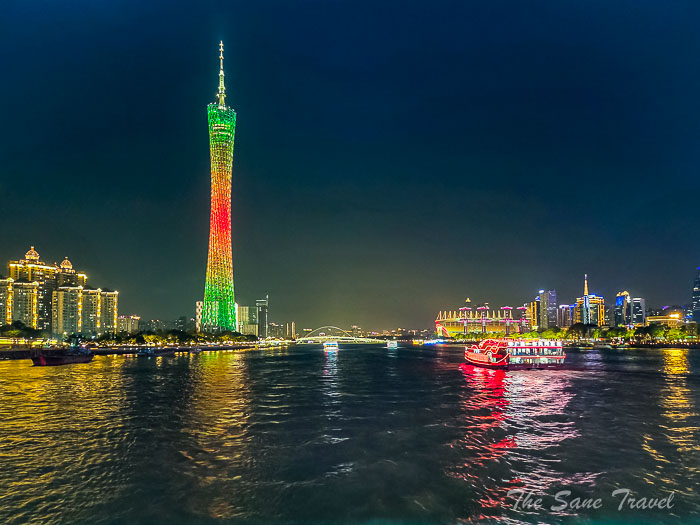
Day 1
Chen Clan Ancestral Hall, Renwei Taoist Temple, Liwan Lake Park, Cantonese Opera Art Museum, Chubby Women sculptures at Huacheng Square, drink at the Four Seasons Hotel, Canton Tower, and Pearl River Night Cruise. Start your day with a visit to the Chen Clan Ancestral Hall.
Chen Clan Ancestral Hall
The Chen Clan Ancestral Hall is regarded as the most well-preserved and exquisitely decorated example of ancestral hall-style architecture in China, earning it the nickname "Jewel of Lingnan Architectural Art". It stands as a prime example of traditional Chinese architecture, renowned for its intricate carvings and detailed sculptures. Originally built as a temple and study hall for the Chen family, the building now houses the Guangdong Folk Art Museum, showcasing a rich collection of local art and crafts.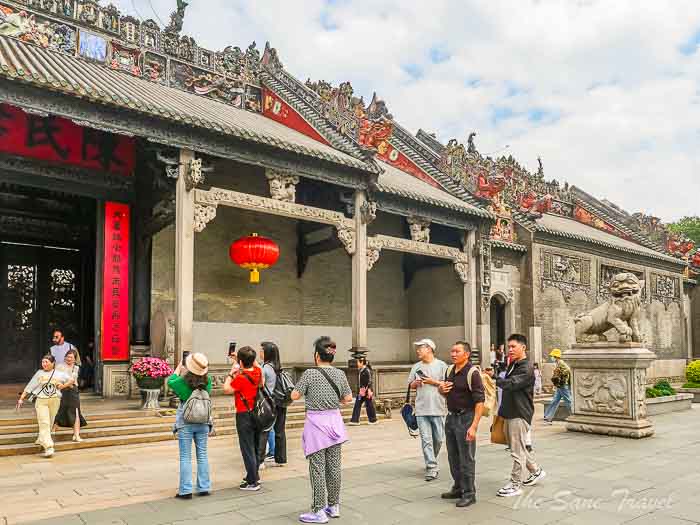

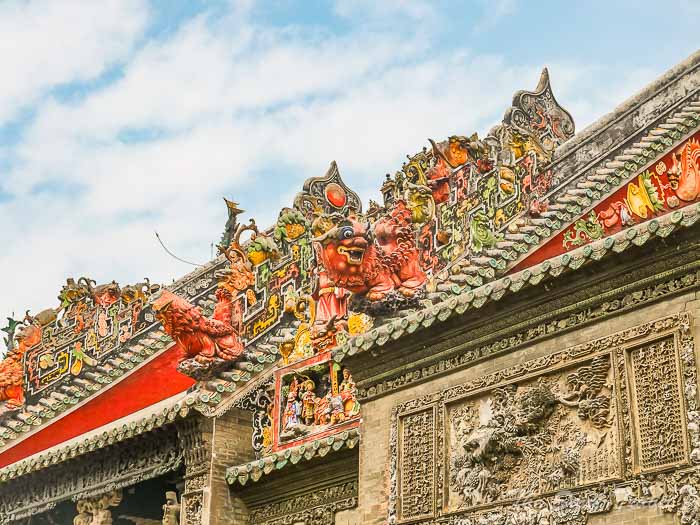
After your visit, continue on foot to the Renwei Ancestral Temple.
Renwei Ancestral Temple
The Renwei Ancestral Temple, built in 1052 during the Song dynasty, is adorned with vivid paintings and finely detailed carvings in wood, brick, and grey stone. According to legend, two brothers named Ren and Wei discovered a large rock while fishing in the village of Pantang. They brought it home and began worshipping it as a statue, which supposedly brought prosperity to their lives. The villagers later raised funds to build a temple in honour of the rock, naming it Renwei Temple.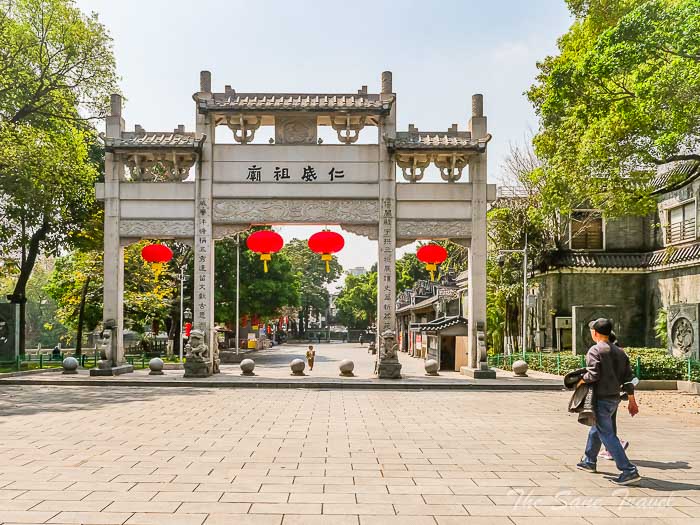
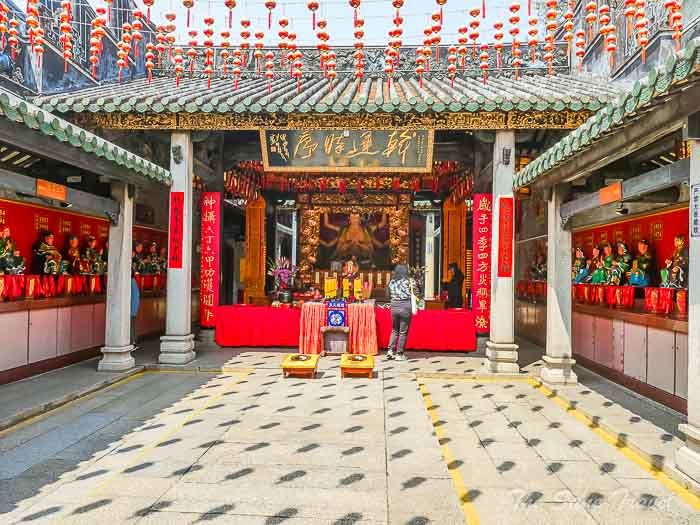
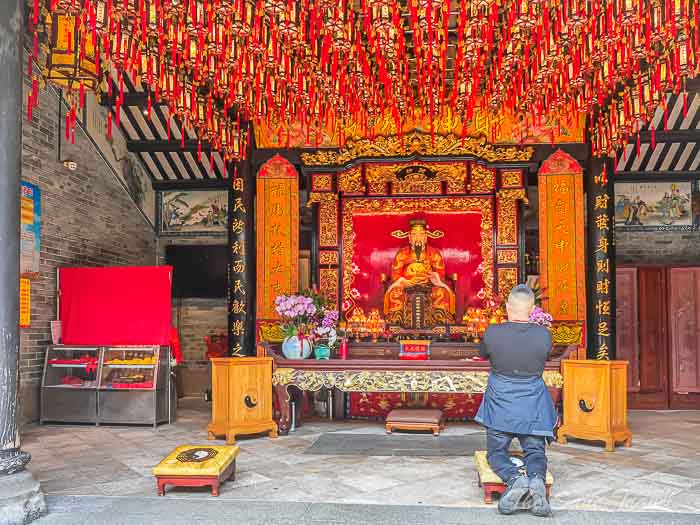 The temple is close to Liwan Lake Park, where your tour will continue.
The temple is close to Liwan Lake Park, where your tour will continue.
Liwan Lake Park
Liwan Lake Park spans 27 hectares, with the interconnected lakes Xiaocui, Yucui, Ruyi, and Wuxiu occupying more than half the area. This urban park provides a serene setting, featuring a harmonious blend of water bodies and lush green spaces. Visitors can enjoy various amenities such as restaurants, cafés, dance halls, and recreational facilities within the park. Locals frequently engage in cultural activities like singing Cantonese opera, dancing, playing Chinese chess, and enjoying morning tea. 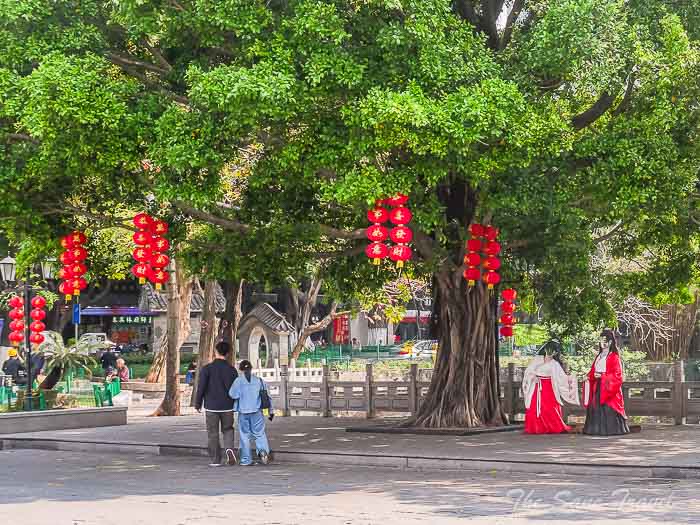
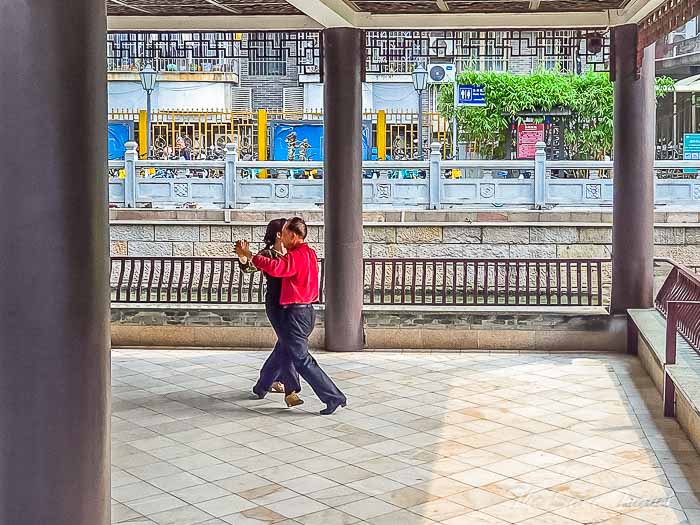
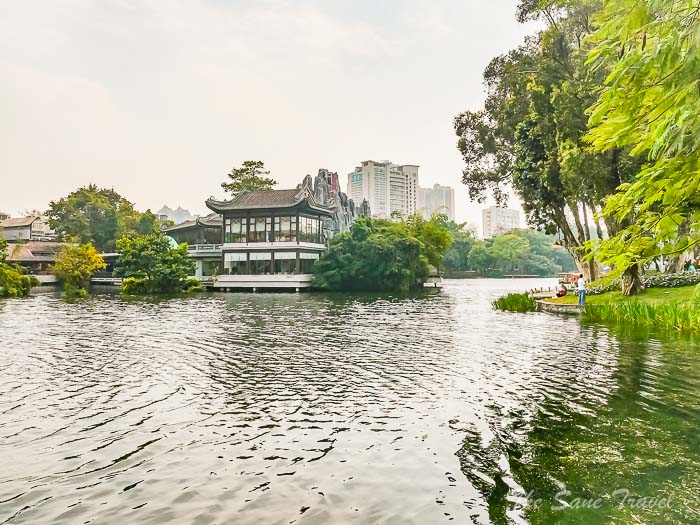
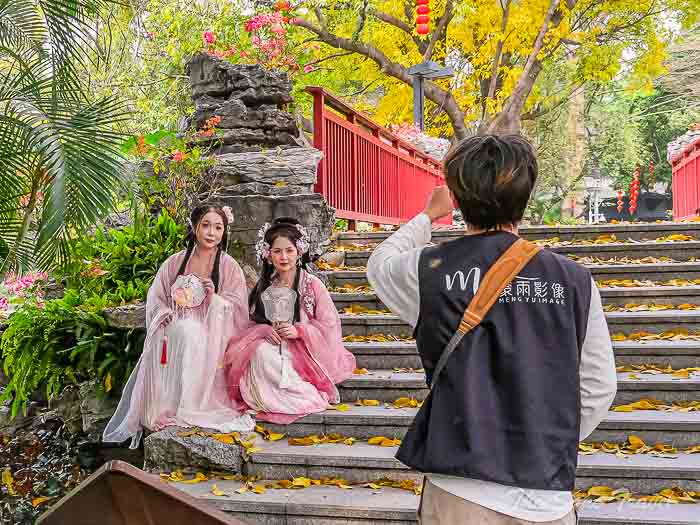 Liwan Lake Park is the perfect spot for picnics and leisurely strolls by the lake, offering visitors a chance to immerse themselves in an authentic Cantonese lifestyle. Its standout feature is the expansive greenery and traditional Lingnan-style architecture, including pavilions, bridges, galleries, and cosy resting spots that blend seamlessly with the natural landscape. Your next stop is the Cantonese Opera Art Museum.
Liwan Lake Park is the perfect spot for picnics and leisurely strolls by the lake, offering visitors a chance to immerse themselves in an authentic Cantonese lifestyle. Its standout feature is the expansive greenery and traditional Lingnan-style architecture, including pavilions, bridges, galleries, and cosy resting spots that blend seamlessly with the natural landscape. Your next stop is the Cantonese Opera Art Museum.
Cantonese Opera Art Museum
The Cantonese Opera Art Museum in Guangzhou is a highly recommended destination for those interested in cultural experiences. Covering 17,000 square metres, the museum showcases classic Lingnan architecture typical of Guangdong Province. Since its establishment in 2016, it has highlighted the rich heritage of Cantonese opera while also presenting a diverse collection of Cantonese art. The beautifully designed gardens, complete with water features and intricate carvings, offer a picturesque outdoor setting. Awarded the prestigious China Construction Engineering Luban Prize in 2017, the museum's architecture reflects traditional local styles, incorporating elements such as rockeries, koi fish ponds, pagodas, and cobblestone paths. Free shows take place regularly on both the indoor and outdoor stages, with plenty of room for big crowds.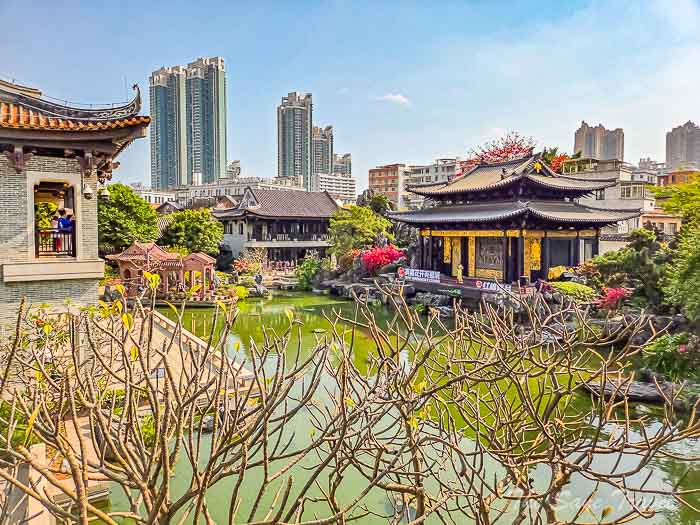
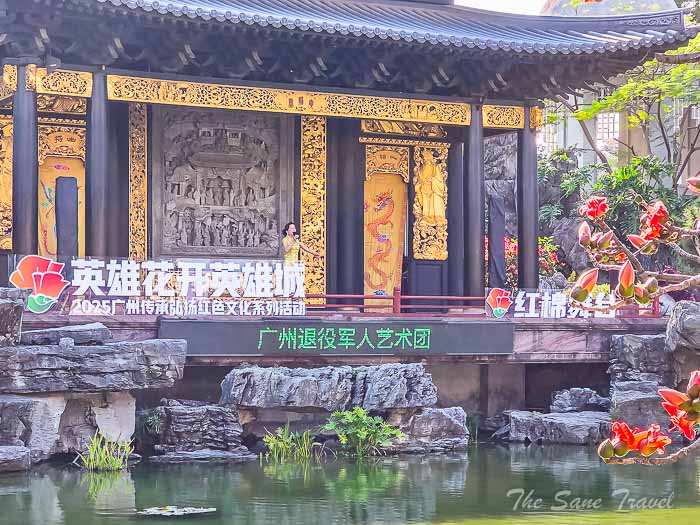
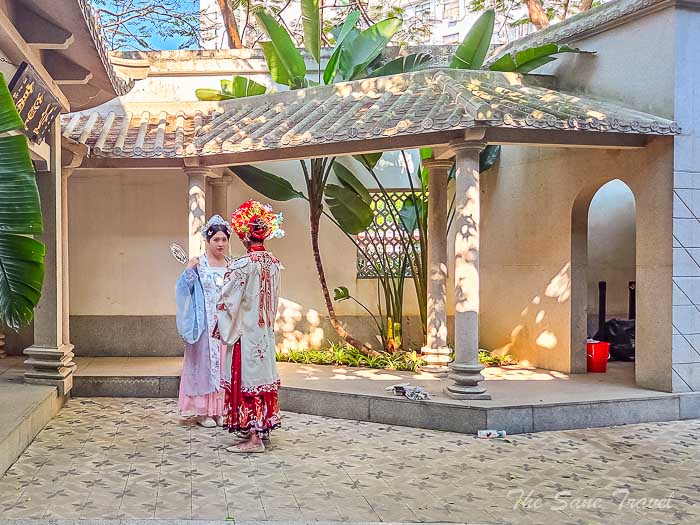
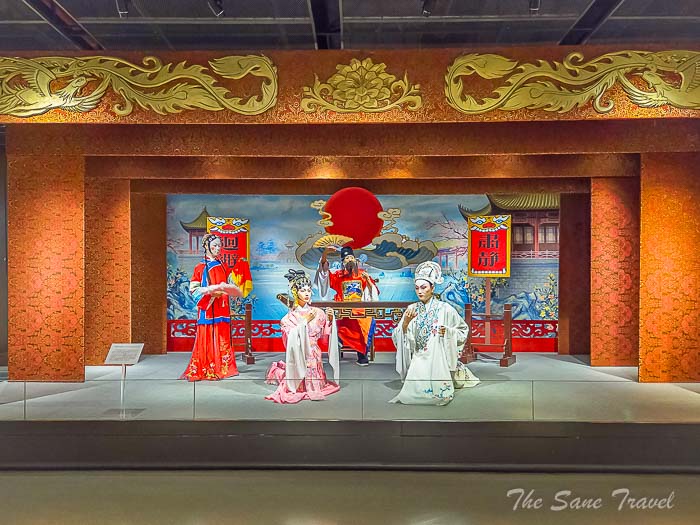
Continue your tour by taking the metro to Huacheng Square. From Changshou Road Station, travel to Tiyu West Road Station, then transfer to Line 3 and get off at Zhujiang New Town Station. Leave the station via Exit D.
Chubby Women at Huacheng Square
A collection of sculptures depicting strong women can be seen at Huacheng Square in Guangzhou. These works are by artist Xu Hongfei, known for his whimsical art that promotes a positive outlook on life. One of Xu’s most famous series is the Chubby Women sculptures, which portray larger-bodied women going about their daily lives.This series has garnered considerable praise in recent years for challenging traditional beauty standards and instead showcasing qualities such as confidence, humour, and joy. The sculptures are currently exhibited throughout the centre of Guangzhou, embodying the city's spirit.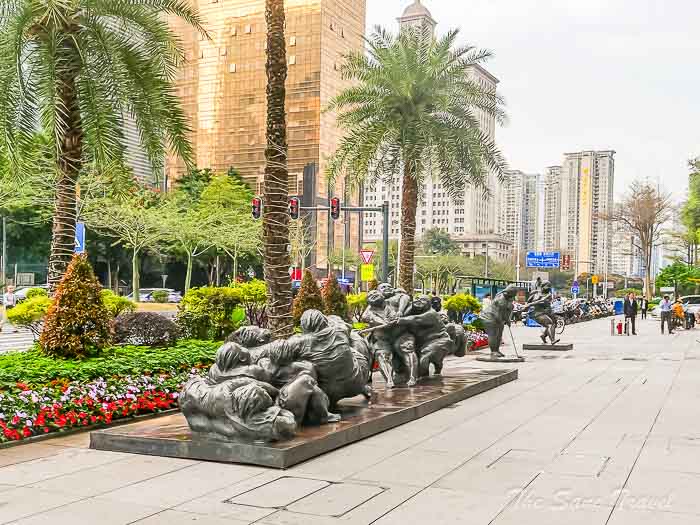
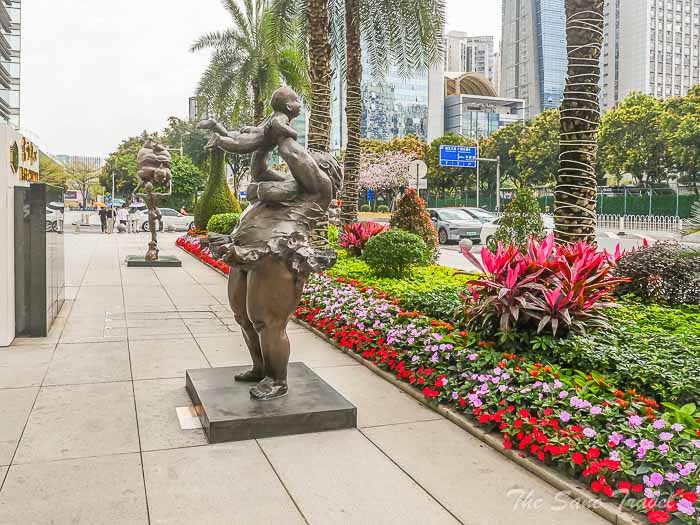 After viewing the sculptures, visitors can enjoy a drink while taking in the views at the nearby Four Seasons Hotel.
After viewing the sculptures, visitors can enjoy a drink while taking in the views at the nearby Four Seasons Hotel.
Four Seasons Hotel
This Guangzhou luxury hotel is situated on the top 30 storeys of the Guangzhou International Finance Centre building, offering breathtaking views of the Pearl River. The Four Seasons Hotel occupies floors 69 to 98, with its lobby located on the 70th floor. Floors 99 and 100 serve as an observation deck and include the CATCH seafood restaurant on the 100th floor and the Tian Bar on the 99th. Below, on the 72nd floor, guests will find the Kumoi Japanese restaurant and the Caffe Mondo Italian buffet, while the Yu Yue Heen Chinese restaurant is on the 71st. The hotel boasts a grand atrium stretching from the 70th to the 100th floor. As the upper-floor restaurants were closed, I visited Caffe Mondo on the 72nd floor and enjoyed a drink with a stunning view – even from the café bathroom.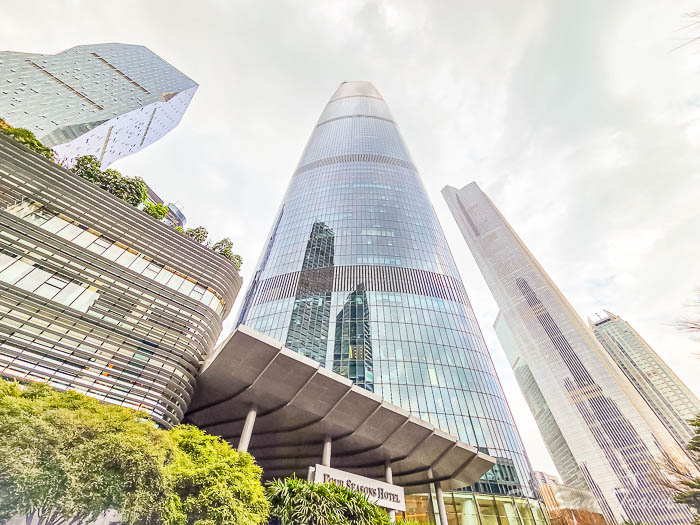
.jpg)
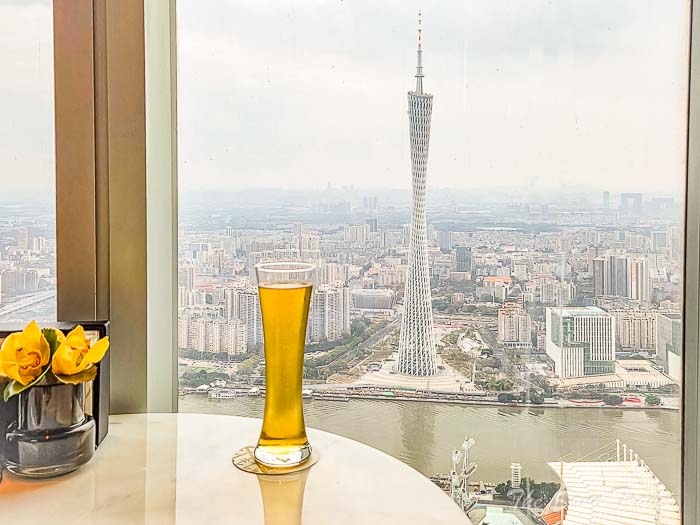
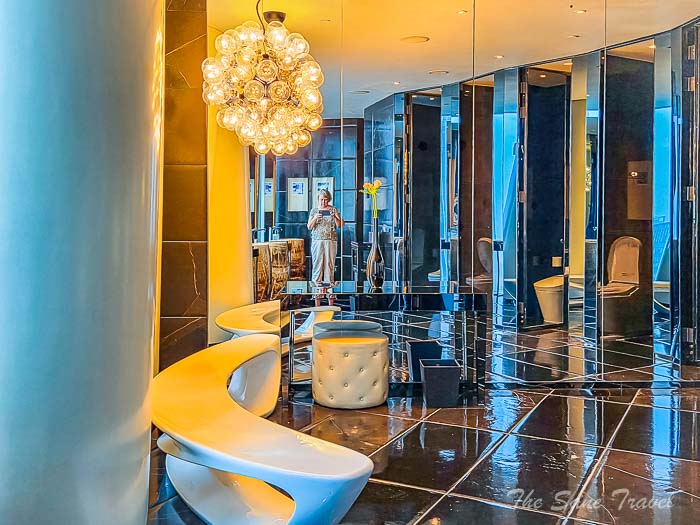
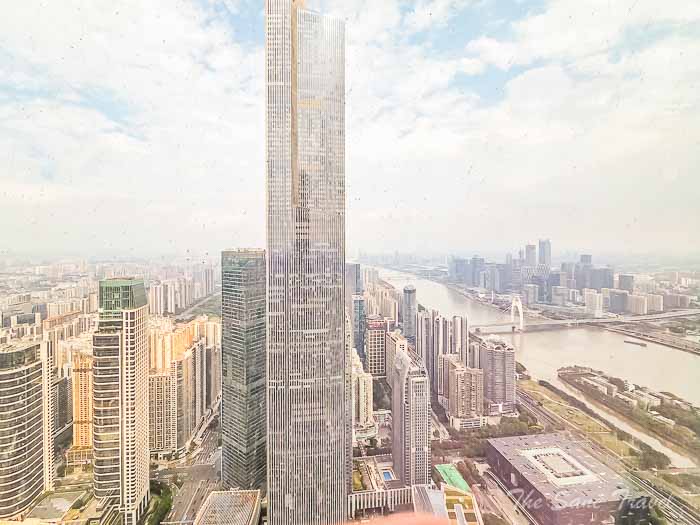 The next recommended destination is the Canton Tower, which is just one metro stop away from Zhujiang New Town Station.
The next recommended destination is the Canton Tower, which is just one metro stop away from Zhujiang New Town Station.
Canton Tower
The Canton Tower is a prominent urban landmark in Guangzhou, serving both as a popular tourist destination and a TV broadcasting station. Standing 600 metres tall, it was completed in September 2009 and is the tallest TV tower in China as well as the third tallest in the world. The tower is well-known for its distinctive "Slim Waist" design, offering visitors panoramic views of the city from the observation deck at 448 metres. One unique feature of the Guangzhou Tower is its open-air viewing platform at the top, allowing tourists to enjoy unobstructed views.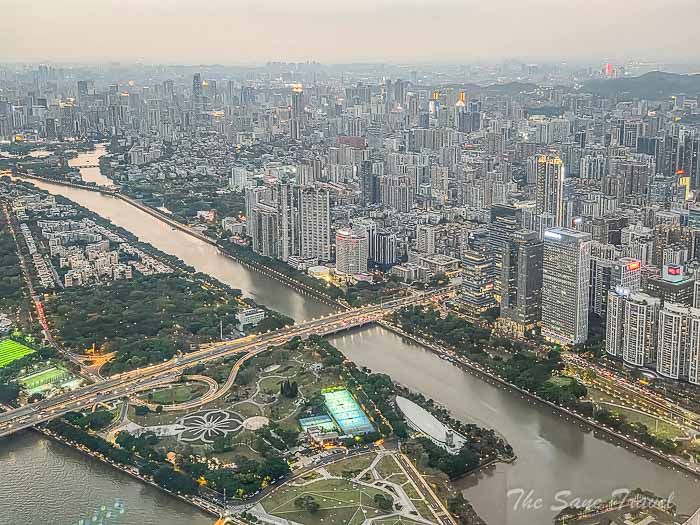
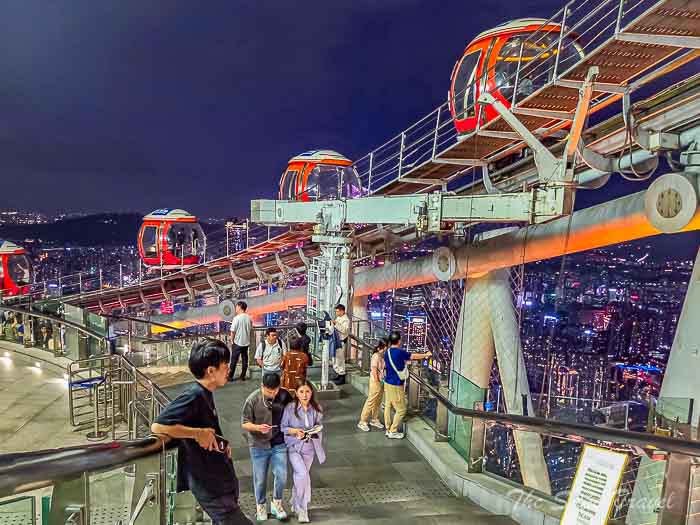
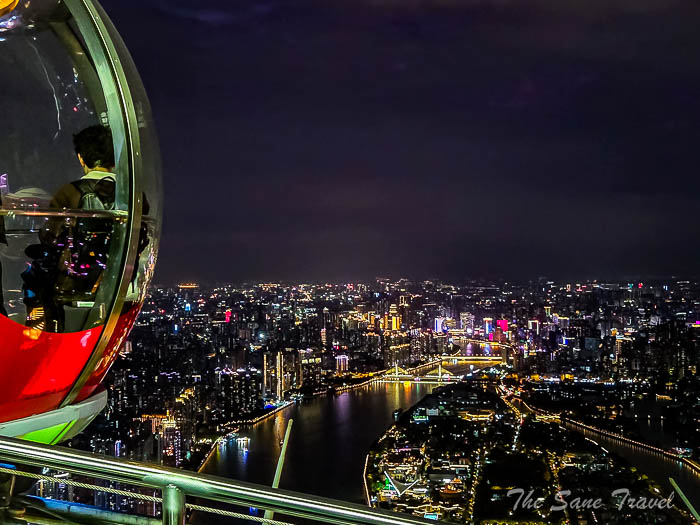 At night, the tower is illuminated in a stunning light display, creating a memorable sight for onlookers. Additionally, tourists can challenge themselves by climbing the world's longest spiral staircase, and experience the highest Ferris wheel and Sky Drop ride, all of which hold Guinness World Records. The tower also houses a revolving restaurant providing diners a unique vantage point over the city.
At night, the tower is illuminated in a stunning light display, creating a memorable sight for onlookers. Additionally, tourists can challenge themselves by climbing the world's longest spiral staircase, and experience the highest Ferris wheel and Sky Drop ride, all of which hold Guinness World Records. The tower also houses a revolving restaurant providing diners a unique vantage point over the city.
Sightseeing cruise along the Pearl River
The Pearl River is the third-longest in China, stretching approximately 2,400 km. One popular activity in Guangzhou is the Pearl River Night Cruise, which offers stunning views of the city's illuminated skyline. Guangzhou has numerous attractions along the riverside, from Shamian in the west to the Pearl River New Town in the east. The city boasts a rich history of trade and urban development, with its modern skyscrapers adding to the city's beauty when seen from the river. There are various river cruise options, ranging from small boats to larger vessels, with dining experiences available exclusively on the larger ones. Boats depart from several piers along the river, including West Pier, Tianzi Pier, Da Sha Tou Pier, Haixinsha Pier, Sun Yat-sen University Pier, and Guangzhou Tower Pier. While the Guangzhou Tower Pier may not provide the best value for money, it is convenient for those visiting the Canton Tower. If time allows, consider exploring other cruise options.
.jpg)
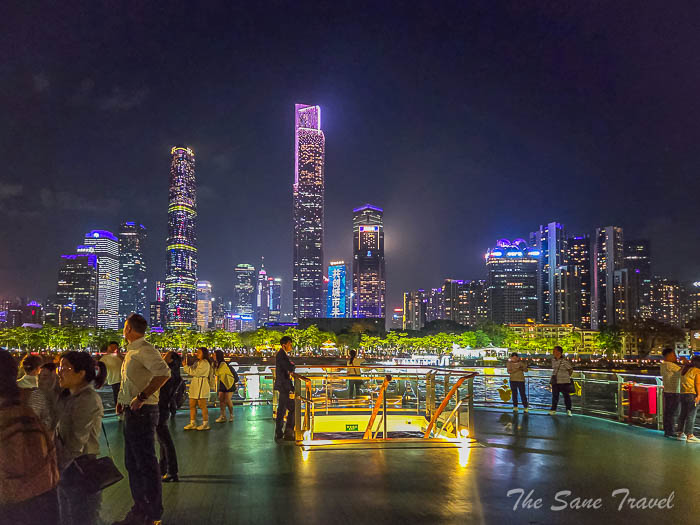
Day 2
Yuexiu Park with Five Rams Statue, Mausoleum of Nanyue King, Shamian Island, and Beijing Road.
Yuexiu Park
Yuexiu Park is the largest park in the city, featuring scenic landscapes, tranquil lakes, and significant historic landmarks. It offers a peaceful retreat from the city's hustle and bustle and serves as a popular destination for recreational activities. With an area of 86 hectares, the park is home to three man-made lakes and seven hills, known collectively as Yuexiu Mountain, from which the park derives its name. It combines cultural heritage with natural beauty, boasting notable attractions such as the Five Rams Statue, Sun-Yat-sen Monument, Zhenhai Tower and remnants of the Ming Dynasty City Wall.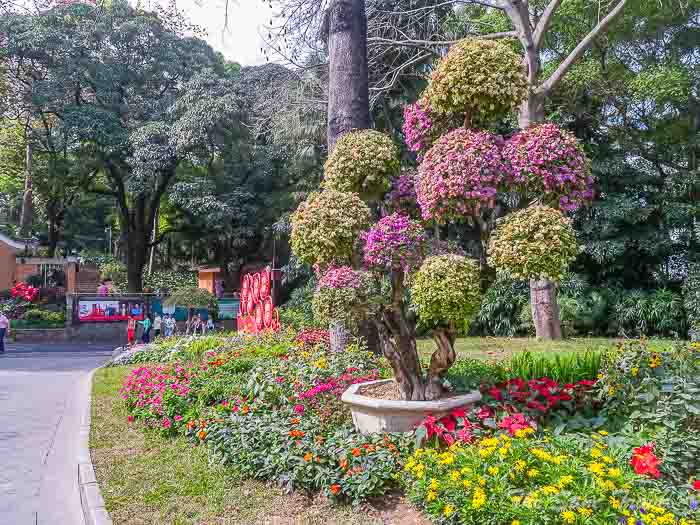
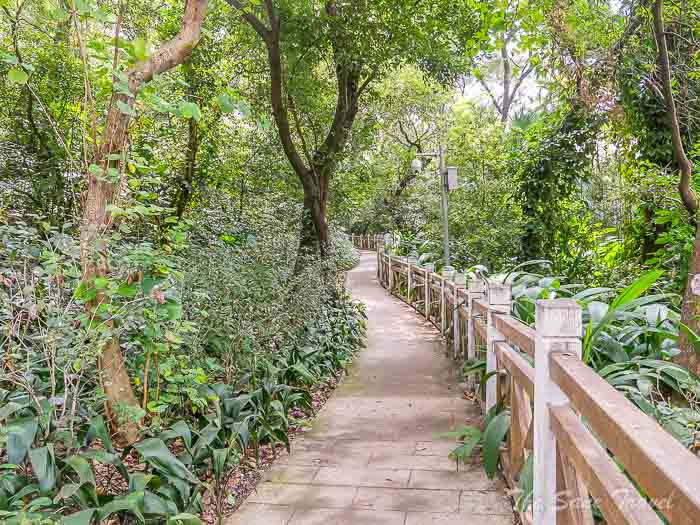
Five Rams Statue
The Five Rams Statue is one of Guangzhou's most famous landmarks and a symbol of the city. According to legend, more than 2,000 years ago, the city was suffering from famine until five immortals, dressed in five colours, arrived riding five rams, each carrying a sheaf of rice in its mouth. The immortals left the rice for the locals, blessed the city, and departed, leaving the rams to turn into stone. This event is credited with transforming Guangzhou into a prosperous and thriving place, giving rise to the nicknames "City of Rams" and "City of Rice Ears". Today, it remains a popular spot for visitors to take photos while exploring Guangzhou.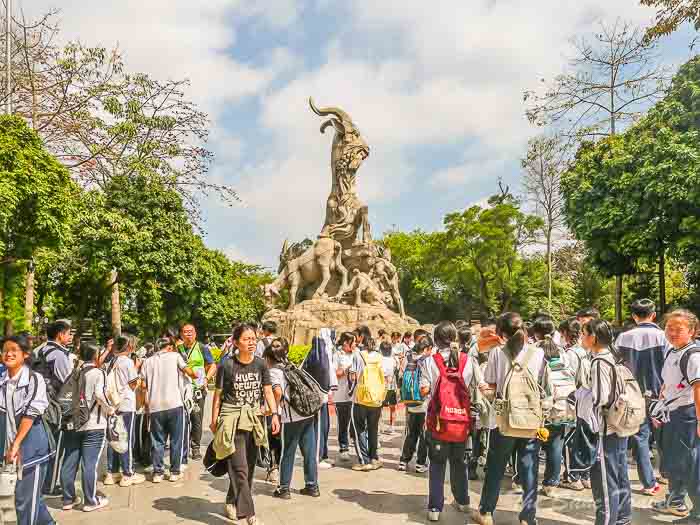
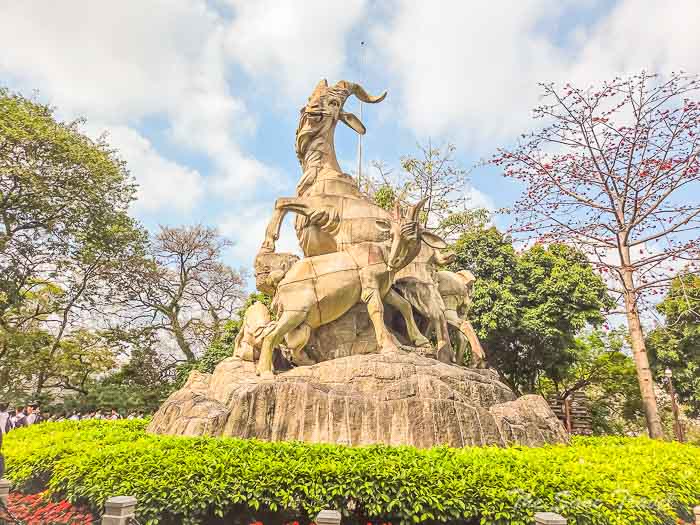
Sun Yat-sen Monument
The monument to Sun Yat-sen, the father of modern China, stands proudly on Yuejinggang Peak in Yuexiu Park. Completed in January 1930 and designed by Lü Yanzhi, it reaches a height of 37 metres. The monument faces south and is constructed from granite in the shape of a square pyramid. Its base has a square design, with the monument body rising above it. A granite stone engraved with the Will of the Prime Minister stands at the front. Encircling the platform at the base, stone railings adorned with 26 sheep-head sculptures reflect Guangzhou's nickname, the "City of Rams".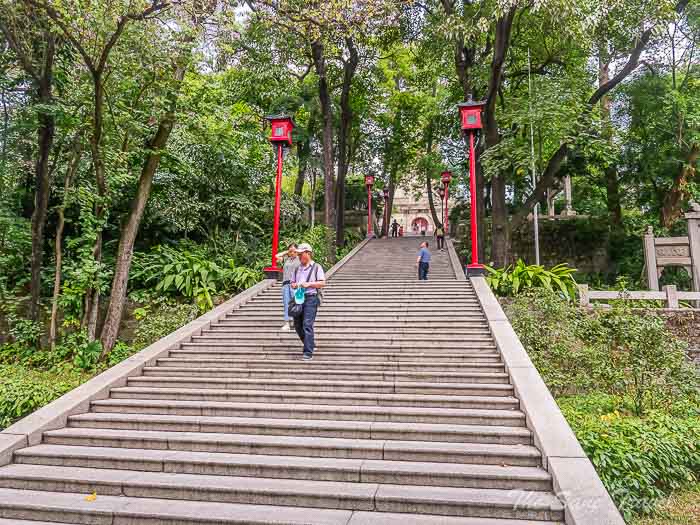
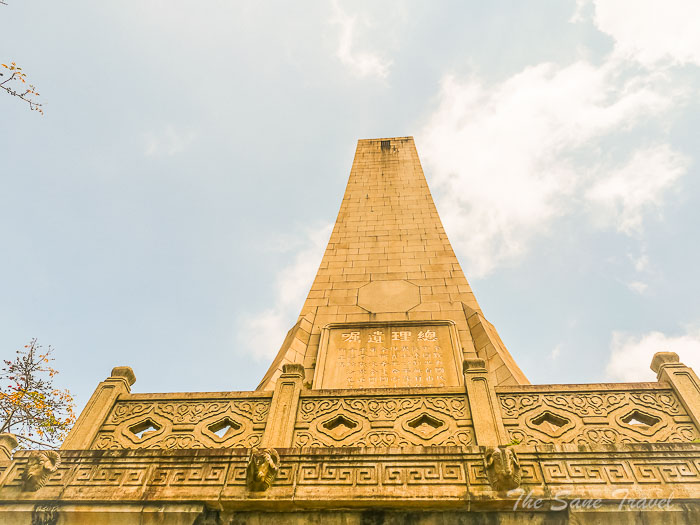
Ming Dynasty Wall
The Ming Dynasty Wall in Yuexiu Park is the only remaining ancient city wall in Guangzhou, dating back to the early Ming period (1368–1644). It currently measures 1,137 metres in length. A distinctive feature of the wall is the presence of several ancient trees growing from it, their roots entwining around the structure – a rare sight among ancient city walls. Many visitors come to photograph the wall, while locals frequently use the area for exercise.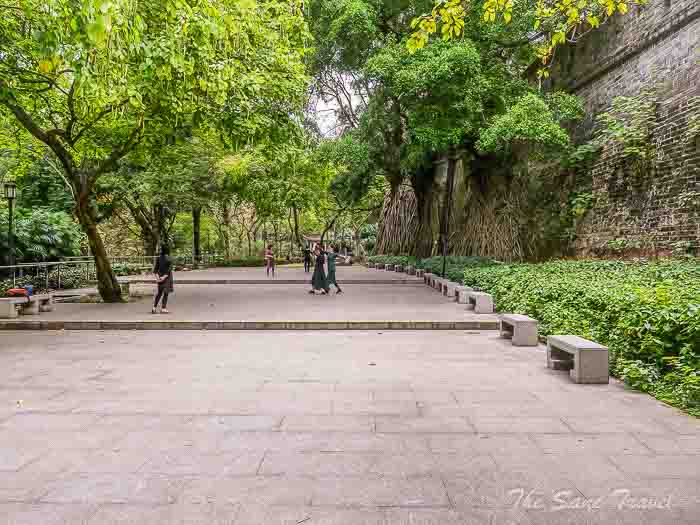
Zhenhai Tower
The Zhenhai Tower, commissioned by Zhu Liangzu in 1380, has been rebuilt five times over the past six centuries. Today, it houses the Guangzhou Museum, which exhibits artefacts and documents spanning the city's 2,000-year history.
Yuexiu Park can be accessed via five gates – Main Gate, East Gate, West Gate, North Gate, and South Gate – each conveniently served by nearby bus stops. It is advisable to start at the Main Gate, accessible via Metro Line 2, and conclude the tour at the West Gate near the Five Rams Statue. From there, visitors can easily walk to the nearby Mausoleum of the Nanyue King.
Mausoleum of the Nanyue King
During the Han period, Zhao Tuo established the Southern Yue Empire in Guangdong, which remained independent from the Han court until 112 BC. The museum exhibits the tomb of Zhao Mo, the second king of Nanyue, along with over 1,000 burial artefacts from the Han dynasty, including the king's jade burial suit. Panyu, now part of Guangzhou, was founded by Zhao Tuo during a failed invasion in 214 BC and became the capital of Nanyue in 204 BC. The Yue people inhabited Guangdong in ancient times, which is why it is sometimes referred to as Yue in Chinese. The Yue were a group of various peoples in southern China during the 5th to 4th centuries BC, but they were not a single ethnic group.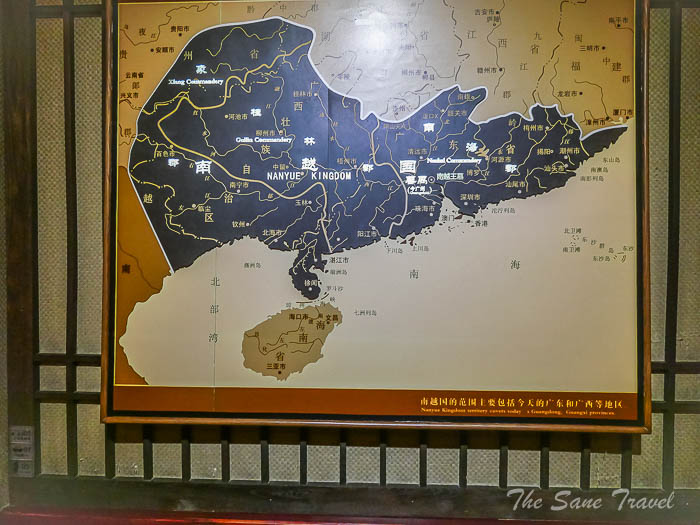
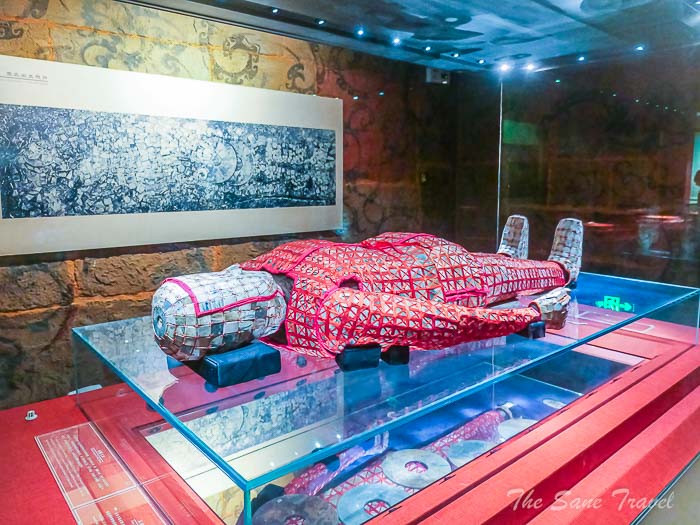
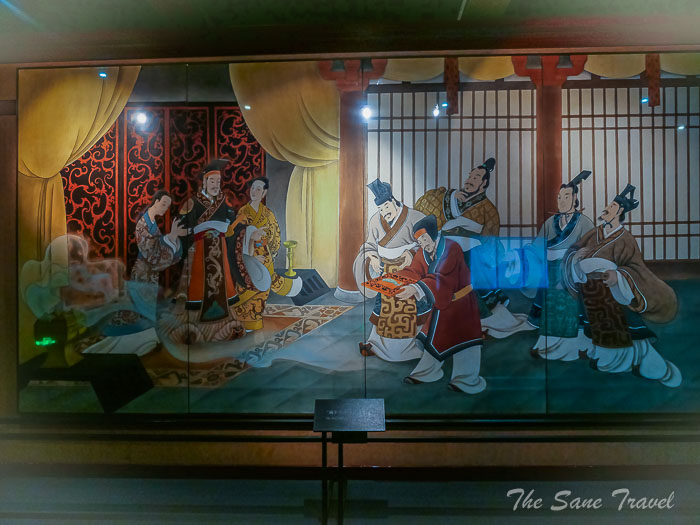
Then continue your tour by visiting Shamian Island.
Shamian Island
Shamian Island in Guangzhou is a historically significant area with a noticeable European influence. Once a hub for foreign trade during the colonial period, it still retains its old-world charm with well-maintained Western-style buildings, quiet pedestrian streets, and lovely gardens, providing a striking contrast to Guangzhou's modern cityscape. 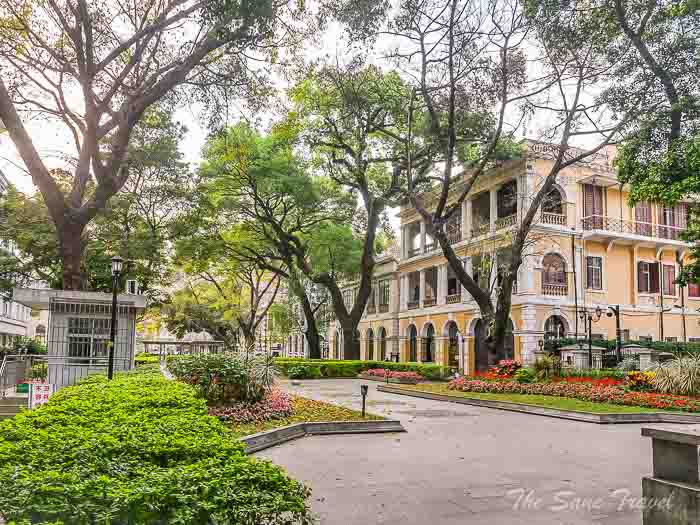
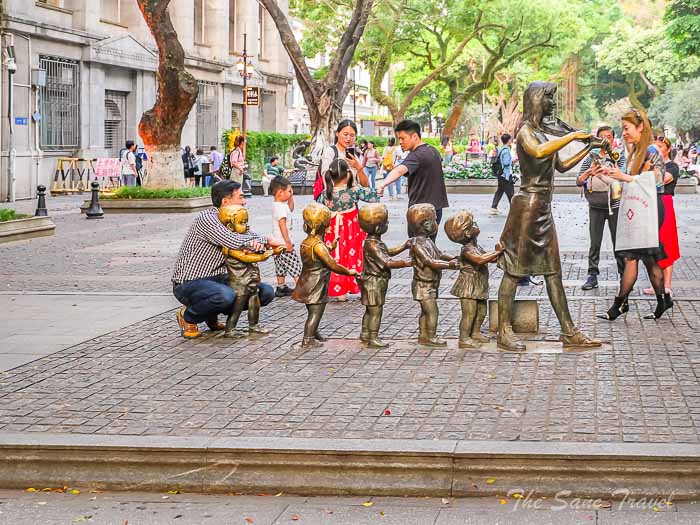 Enjoy a drink and snack at Room 8, a charming tearoom dating back to colonial and Victorian times, with teacups, saucers, teapots, and decorative plates from that era enriching the atmosphere.
Enjoy a drink and snack at Room 8, a charming tearoom dating back to colonial and Victorian times, with teacups, saucers, teapots, and decorative plates from that era enriching the atmosphere.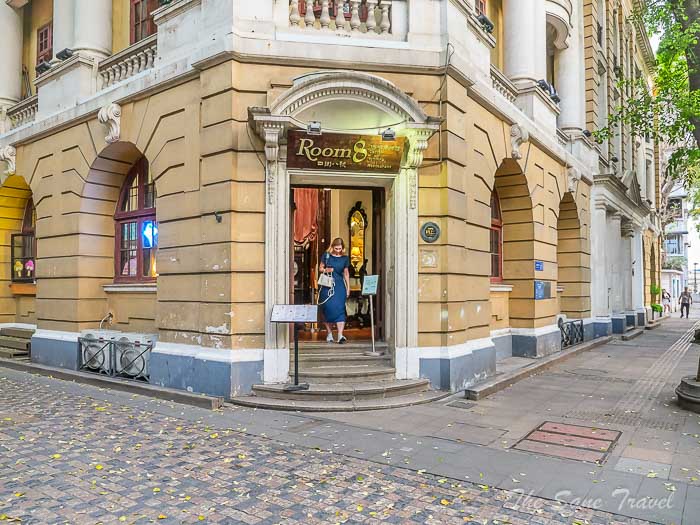
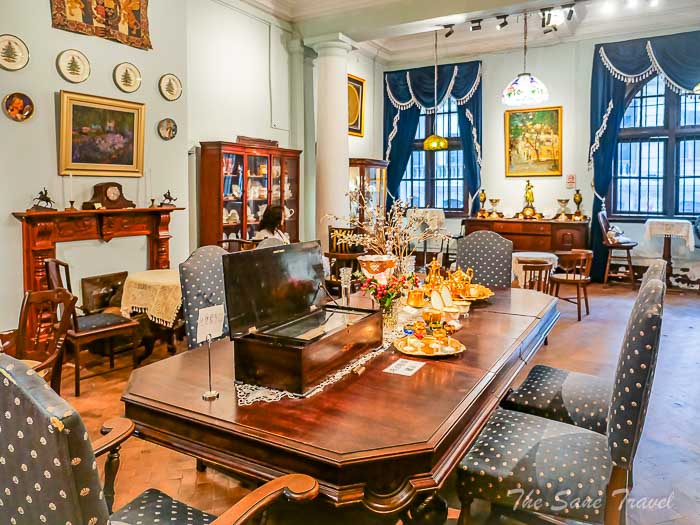 Another fine dining venue, the Orient Express French Restaurant, offers a unique experience that blends French culinary traditions with the romantic atmosphere of a vintage train.
Another fine dining venue, the Orient Express French Restaurant, offers a unique experience that blends French culinary traditions with the romantic atmosphere of a vintage train.
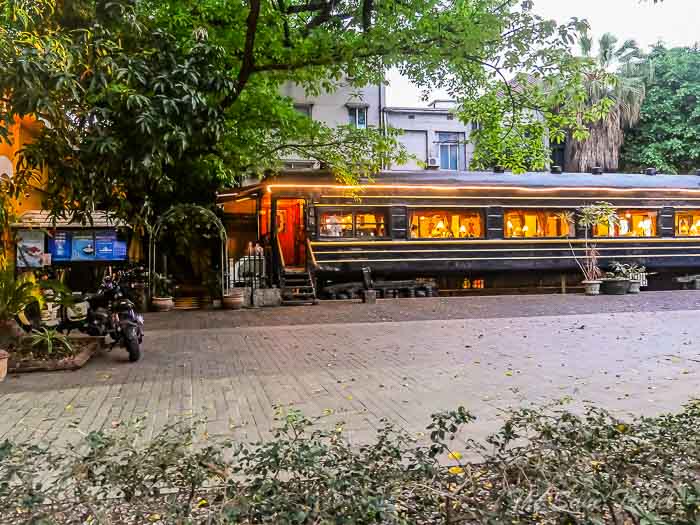
The most convenient way to reach Shamian Island is to take the Guangzhou Metro Line 1 to Huangsha Station and leave via Exit D, which is just a five-minute walk to the island. To end your day, you can visit Beijing Road for some shopping or simply to browse.
Beijing Road
Beijing Road is a bustling shopping area in Guangzhou, popular with both locals and visitors. The street is lined with a mix of shops, restaurants, and historic sites, creating a unique shopping atmosphere.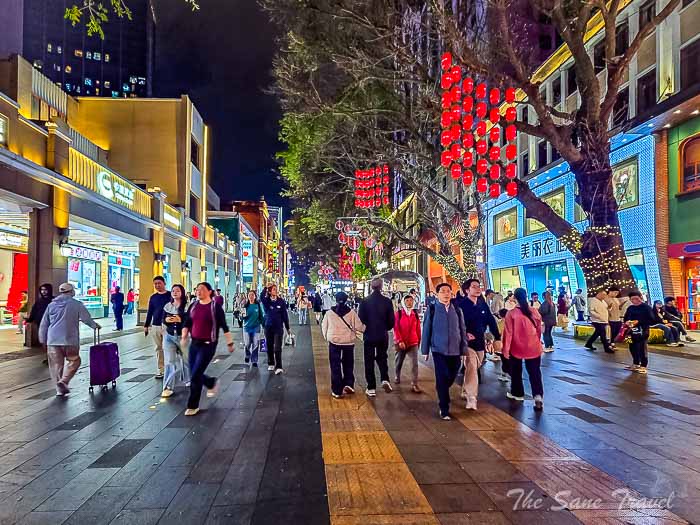
To reach Beijing Road, take Metro Line 6 to Beijing Road Station and leave via Exit B. Alternatively, you can take Metro Line 1 or Line 2 to Gongyuanqian Station, leave via Exit D, and then walk east for approximately 800 metres.
Day 3
Chimelong Safari Park and Chimelong International Circus
Chimelong Safari Park
Chimelong Safari Park is part of the Chimelong Tourist Resort, located in Panyu District. It is China's first and Guangzhou's only 5A-grade scenic area. The park is famous for being the filming location of the popular reality show Dad, Where Are We Going?. Extending over 800 hectares, including a large section of subtropical rainforest typical of southern China, it is considered the largest eco-zoo in the country. Home to more than 500 rare species and over 20,000 animals, Chimelong Safari Park offers a unique and diverse wildlife experience. Visitors can expect to see a wide variety of wild animals from around the world, including rare species such as giant pandas, white tigers, giant salamanders, and elephants.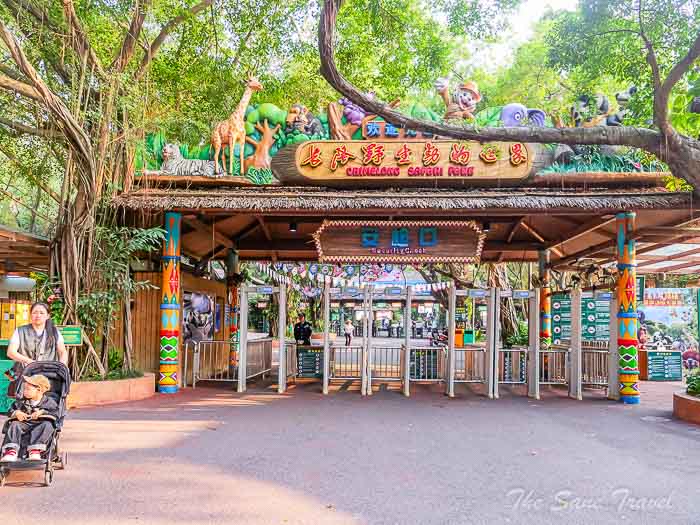
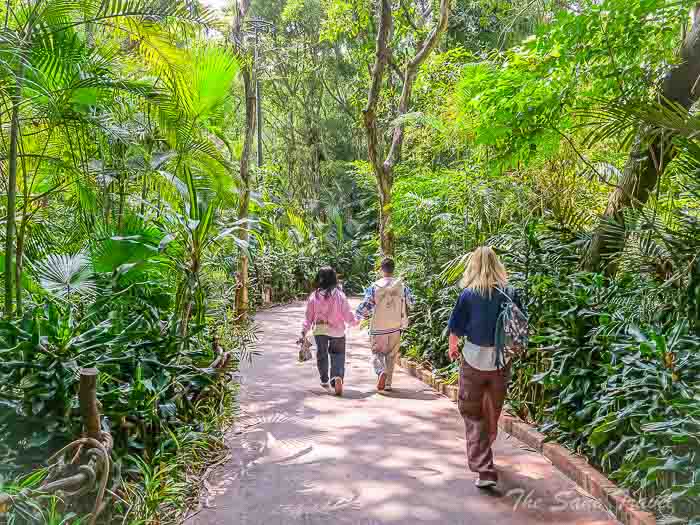
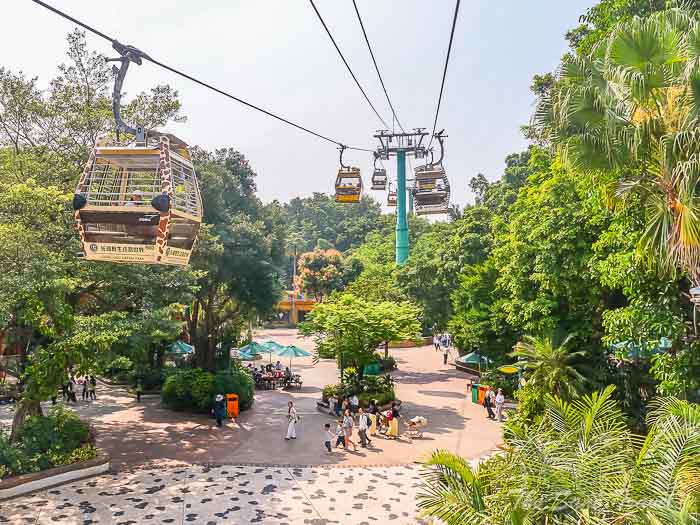
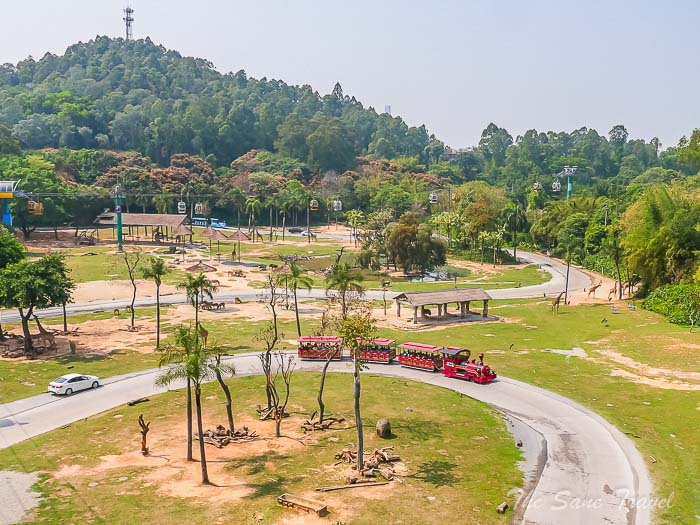

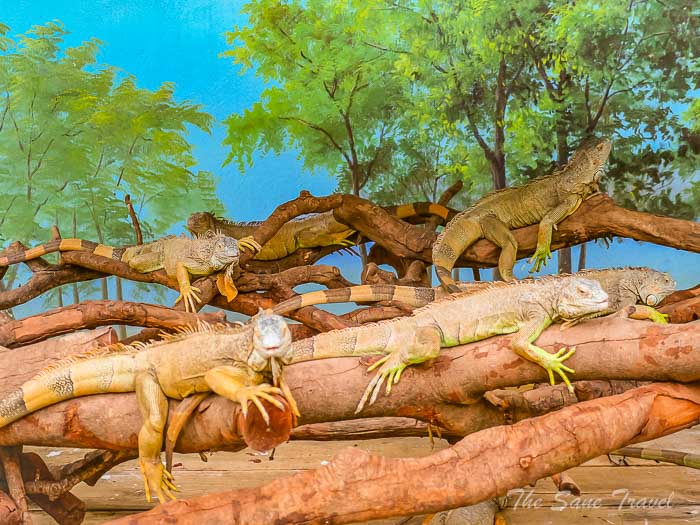
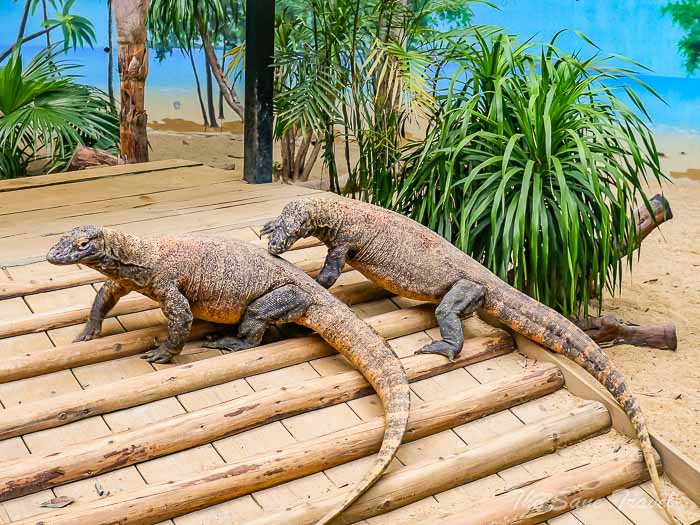
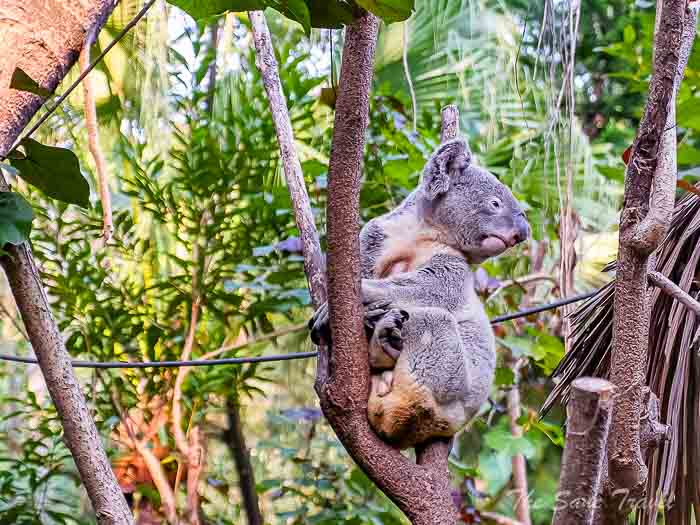
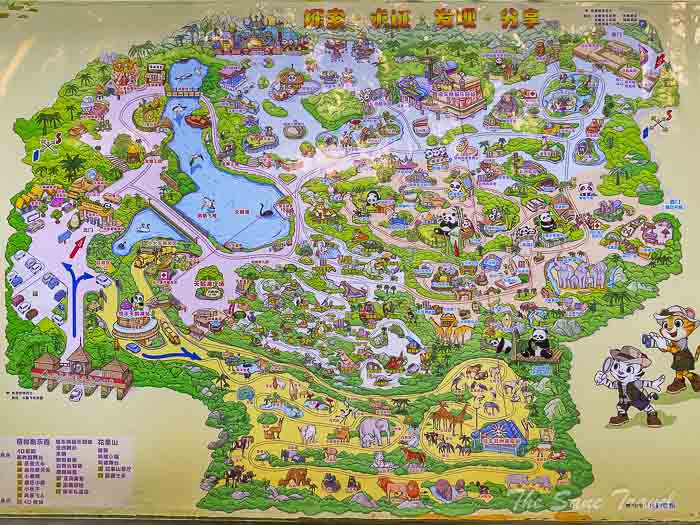
Chimelong International Circus
Chimelong International Circus is known as the world's first circus to feature a live-action stage incorporating advanced stage techniques. The circus arena, the largest in the world, can accommodate up to 8,000 spectators. Since opening in 2000, it has earned a reputation as the world's largest permanent circus, attracting over ten million visitors. The circus showcases more than 300 talented performers from countries across Asia, America, Europe, and Africa, along with 500 animals representing 40 different species. However, for those who do not support the use of animals in entertainment, it may be advisable to skip this part of the tour.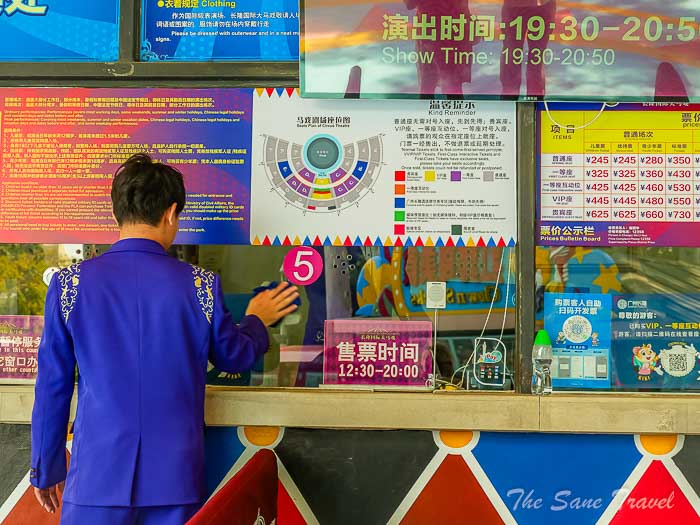
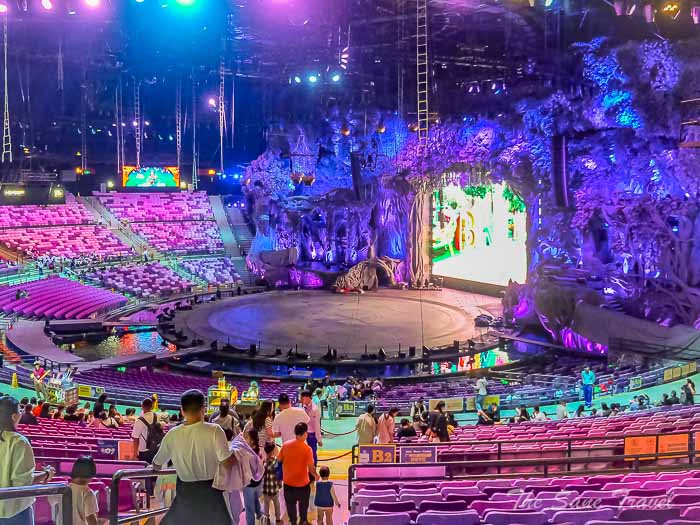
Chimelong Safari Park can be reached via Guangzhou Metro Line 3 by getting off at Hanxi Changlong Station. Outside Exit E, shuttle buses depart directly to the park. For fewer crowds, visiting on a weekday is advised rather than at weekends or public holidays.
Day 4
Qingyuan. Gulong Gorge and Xinyinzhan Hot Spring Holiday Resort
Qingyuan Gulong Gorge
Located in Qingxin District, Qingyuan City, approximately 70 kilometres from Guangzhou, Qingyuan Gulong Gorge is a national 4A-level tourist attraction featuring a large entertainment park set amidst the mountains. Home to lush subtropical rainforest, it occupies 3,000 hectares. Make sure to purchase a ticket that includes the Cloud Glass Skywalk experience at the visitor centre before boarding the shuttle bus to the hiking trail entrance. Along the route, hikers will pass picturesque streams, waterfalls, and realistic dinosaur exhibits.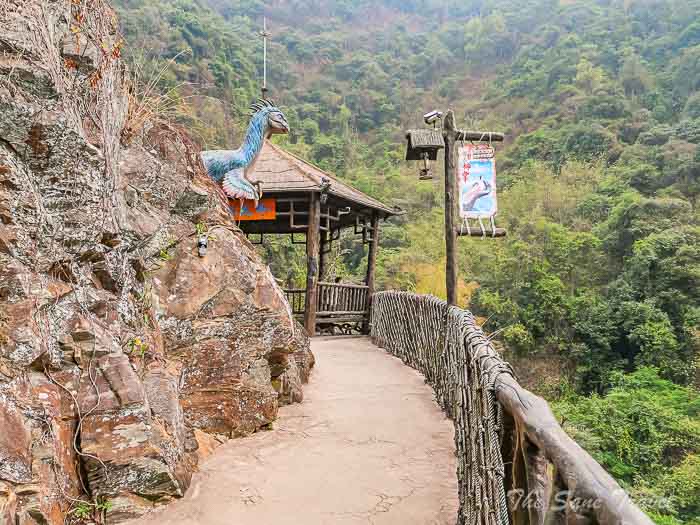
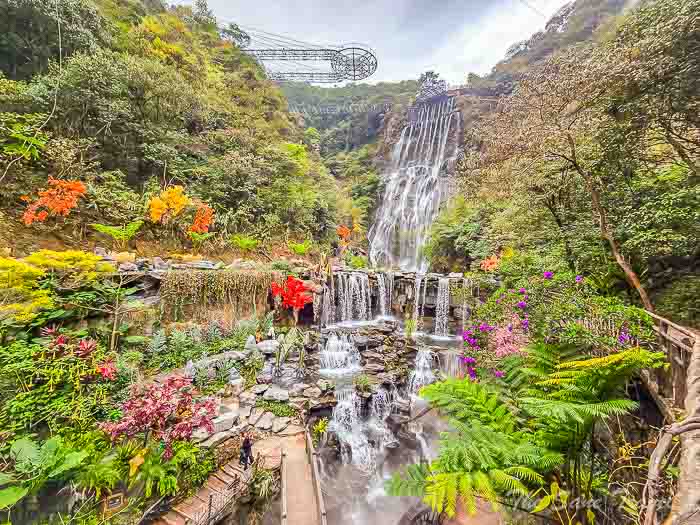 Qingyuan Gulong Gorge boasts the world's longest glass platform, spanning 72 metres, as well as a glass bridge with the widest waterfall view at 6.8 metres. A custom-built glass walkway, suspended nearly 100 metres above ground, links Qingyuan's karst caves.
Qingyuan Gulong Gorge boasts the world's longest glass platform, spanning 72 metres, as well as a glass bridge with the widest waterfall view at 6.8 metres. A custom-built glass walkway, suspended nearly 100 metres above ground, links Qingyuan's karst caves.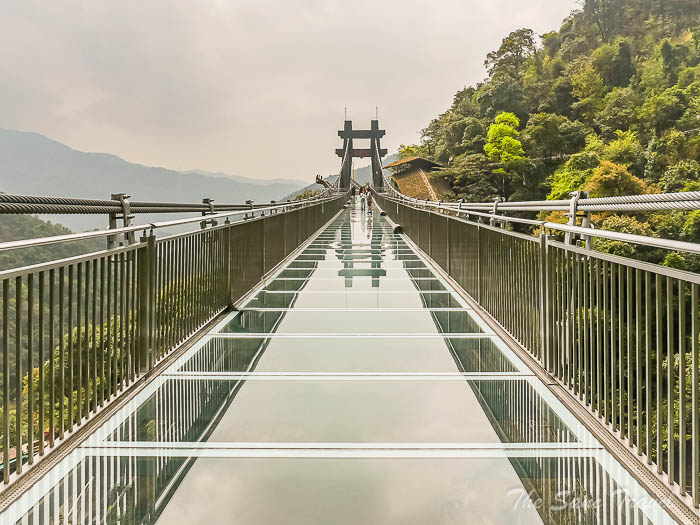
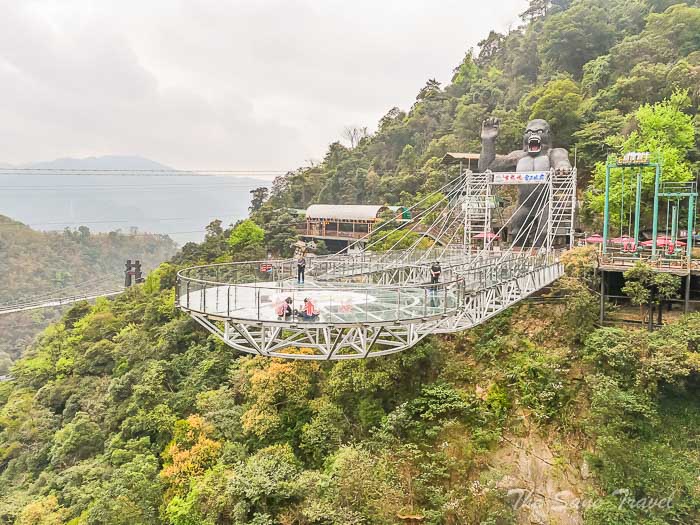
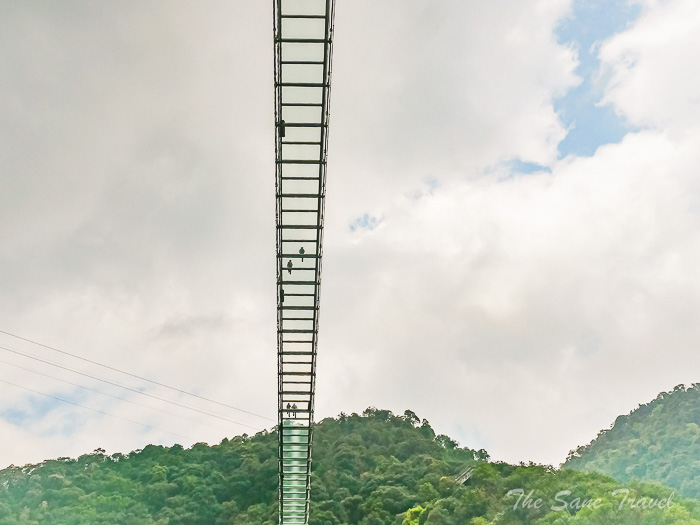 Visitors can also admire nine waterfalls of various sizes and shapes, including the 108-metre-high, 80-metre-wide Gulong Waterfall. Round off your day with a relaxing visit to Xinyinzhan Hot Spring Holiday Resort, easily reached by Didi ride, where you can unwind in soothing natural hot spring pools.
Visitors can also admire nine waterfalls of various sizes and shapes, including the 108-metre-high, 80-metre-wide Gulong Waterfall. Round off your day with a relaxing visit to Xinyinzhan Hot Spring Holiday Resort, easily reached by Didi ride, where you can unwind in soothing natural hot spring pools.
Xinyinzhan Hot Spring Holiday Resort
The Xinyinzhan Hot Spring Holiday Resort is situated approximately 18 kilometres from Qingyuan city centre and 40 kilometres from Guangzhou city centre. The hot pools are well-maintained and kept clean throughout the day. Although I did not stay overnight, I was impressed by the variety of hot spring pools on offer. The staff was regularly seen checking the water quality and temperatures, ensuring a safe environment. 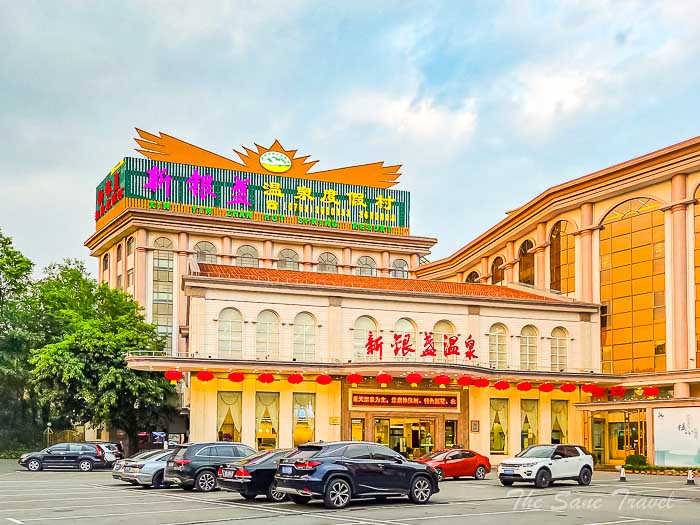
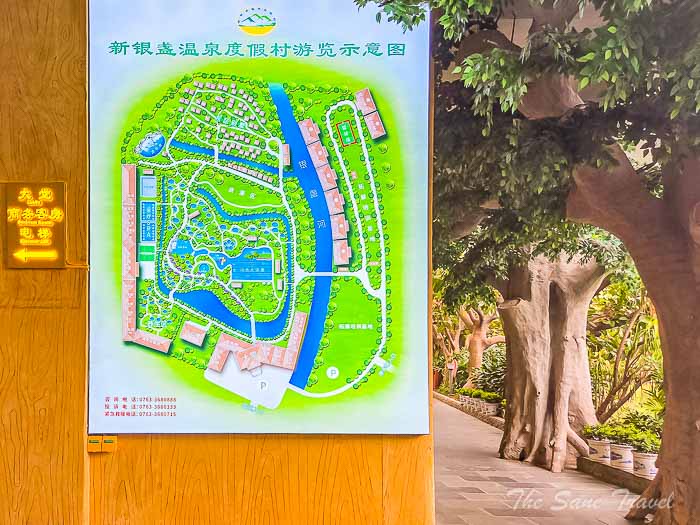
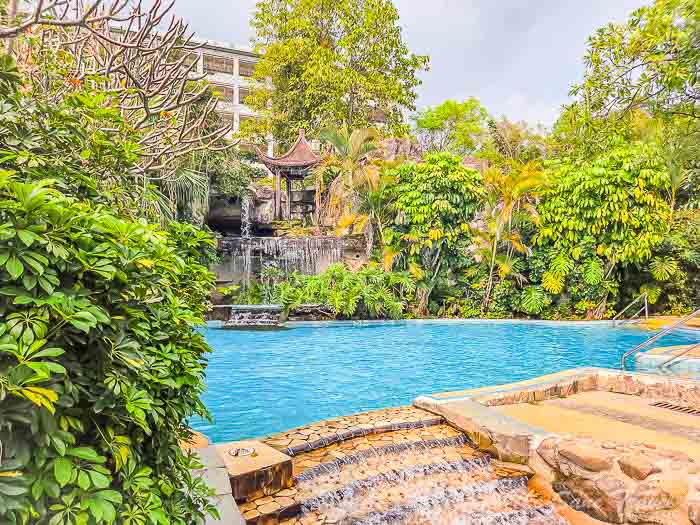
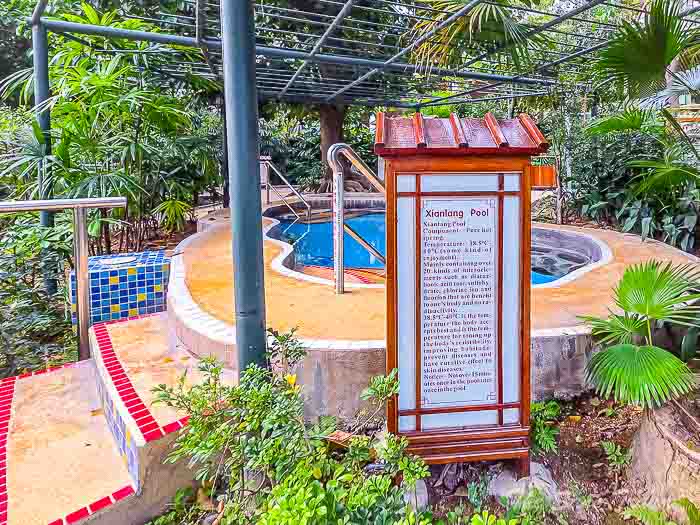
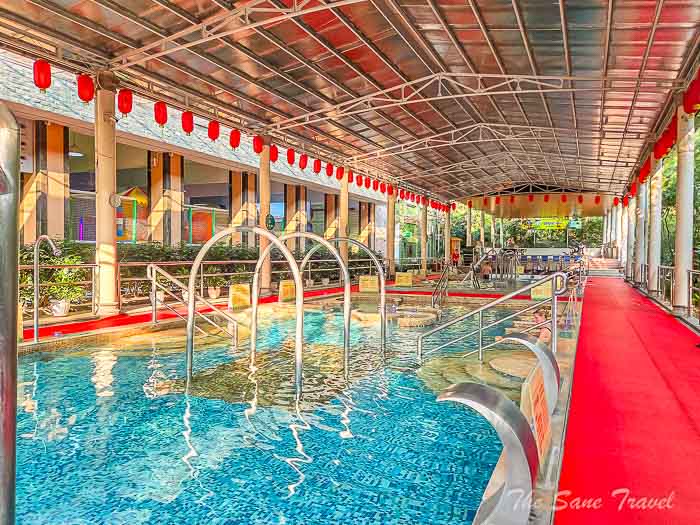
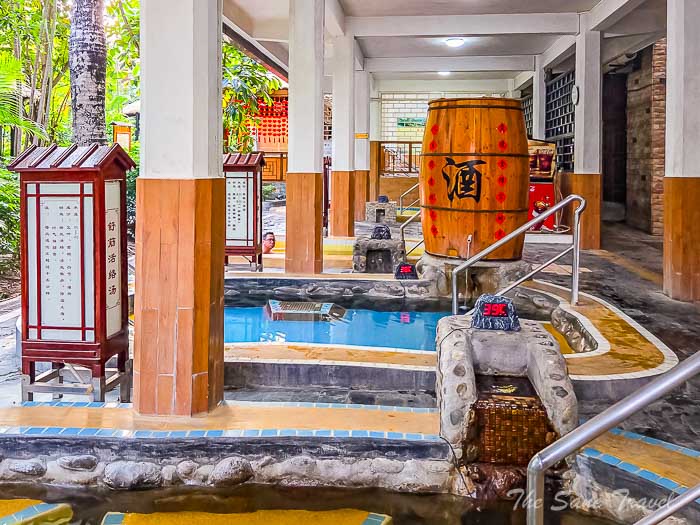 Towels were readily available, and robes could be rented. The on-site restaurant served a satisfactory lunch featuring Chinese cuisine, which is generally a reliable choice.
Towels were readily available, and robes could be rented. The on-site restaurant served a satisfactory lunch featuring Chinese cuisine, which is generally a reliable choice.
Day 5
Baomo Garden and Lotus Hill
Baomo Garden, located in Guangzhou's Panyu District, approximately 35 kilometres from the city centre, covers an area of around 100,000 square metres. This traditional Chinese garden showcases classic Chinese architecture and art. Originally built during the late Qing dynasty, Baomo Garden was designed to complement the nearby Temple of Lord Bao, situated in the eastern part of the garden. I highly recommend visiting Baomo Garden during your time in Guangzhou, as it offers a wide range of attractions.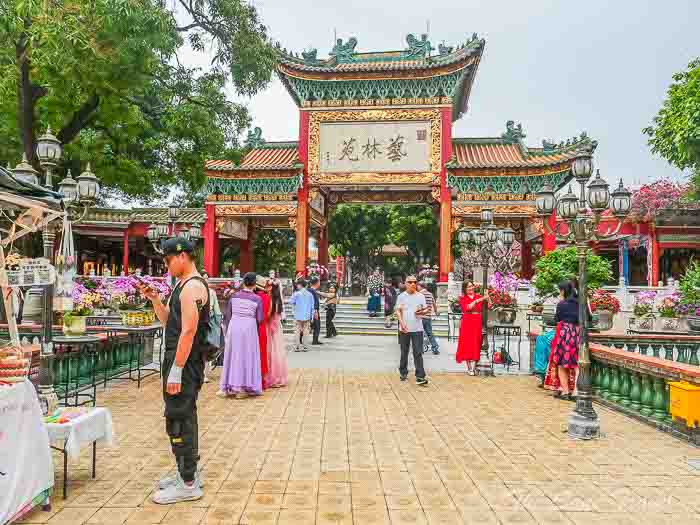
Lotus Hill is situated on the outskirts of Panyu City, approximately 20 kilometres east of Guangzhou. It boasts the most well-preserved ancient quarry site in China, with a history spanning 2,000 years. Occupying an area of 2.54 square kilometres, the hill comprises 48 red sandstone cliffs, the tallest of which rises to 108 metres. Additionally, the hill is home to temples, pagodas, and other structures dating from the Ming dynasty, along with remnants of Lotus City, built during the Qing dynasty under the reign of Emperor Kangxi.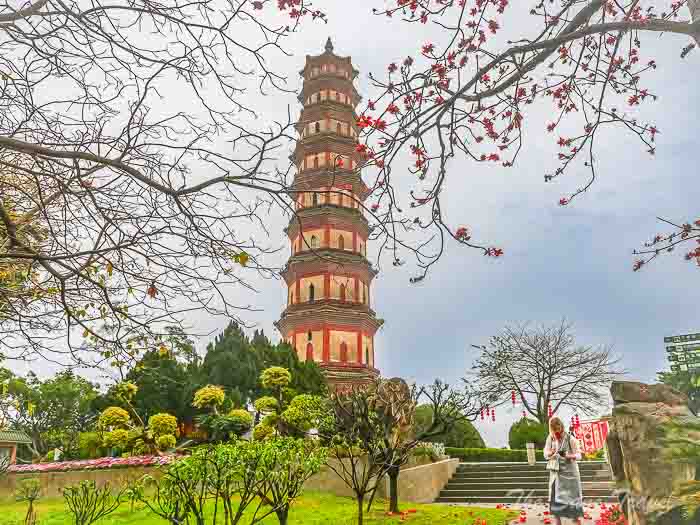
Day 6
Seven Star Crags
When visiting Guangzhou, you might consider exploring the Xinghu Lake Scenic Area near Zhaoqing, about 120 kilometres away. Easily accessible by high-speed train, this area is highly rated as one of China's top tourist destinations. The scenic area includes both the Seven Star Crags and Dinghu Mountain, though my personal experience is limited to the Seven Star Crags. Covering 8.23 square kilometres, this area features karst topography, including peak forests, caves, lakes, stone steles, and Taoist temples, and has been drawing visitors since the 6th century.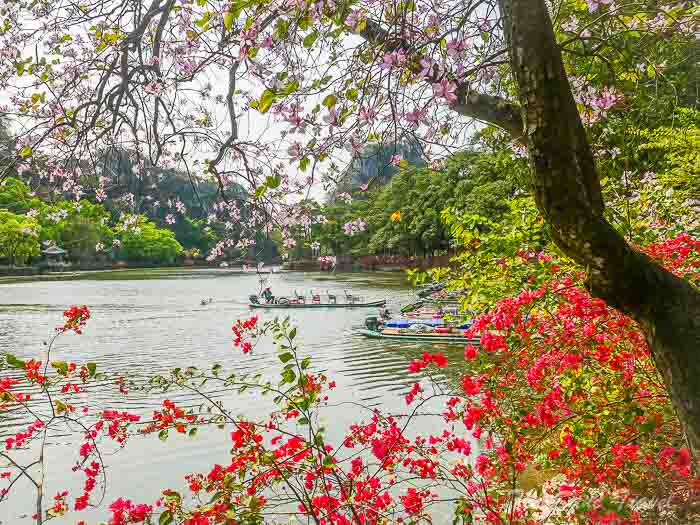
Day 7
Baiyun Mountain
Baiyun Mountain is a popular natural landmark in Guangzhou, renowned for its lush greenery and scenic peaks. Spanning approximately 21 square kilometres, Baiyun Mountain is classified as a national A5-grade scenic area. The area encompasses various parklands with gardens, ponds, and sculptures. New attractions such as Mingchungu Natural Birdcage, Yunluo Botanical Garden, and Yuntai Garden enhance the mountain's diverse landscapes, offering breathtaking views of the city and the Pearl River Delta.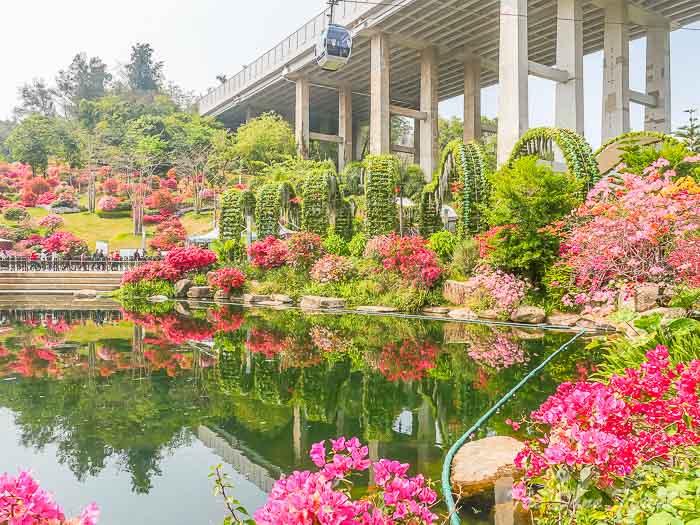
Practical information
You have the flexibility to plan your itinerary in whichever order suits you best. Having internet access during your travels is recommended, and upon arrival at Guangzhou Baiyun Airport, it is advisable to purchase a local SIM card. A power bank is also useful for keeping your phone charged while you are out and about. For payments, you will need the Alipay app, which also includes a mini-program for booking Didi car rides. I found the Trip.com website convenient for purchasing train tickets. Keep in mind that Guangzhou South Railway Station is quite a distance from the city centre, so allow extra time for your journey. I used the Maps.me app for navigation. Amap was helpful, too, although at times it was difficult to understand. Regrettably, Google Maps cannot be utilised as it lacks sufficient data on China to ensure reliability. For staying overnight, I recommend the Guangzhou Garden Hotel.
Like it? Pin it! 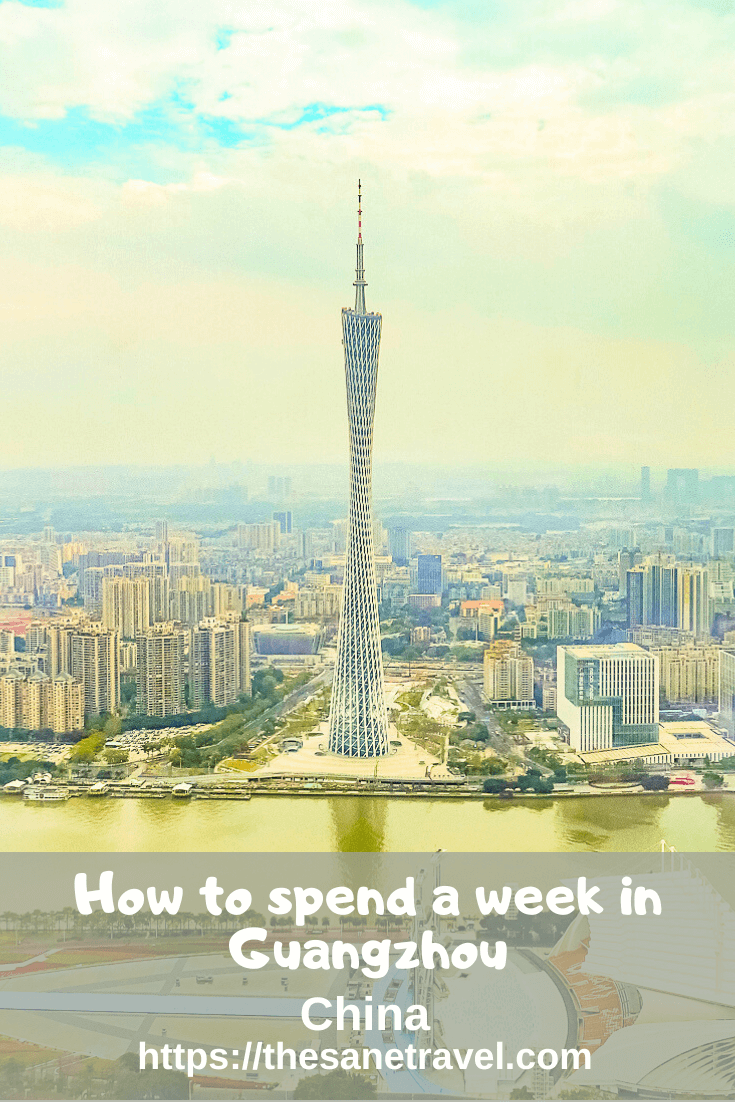
What did you think? Have you been to Guangzhou? I would love to hear from you, so please add your comment below.
Author: Anita Sane

About the author
Anita is a part-time traveller, passionate photographer and a retired career woman from Latvia, travelling mostly solo for more than 15 years. She is a skilled travel planner who plans and executes her travels by herself. Anita wants to show you how to travel the world and open your mind to new experiences. Follow her on Facebook, Instagram, Pinterest, Twitter and Bloglovin.

Report
My comments